Ayurvedic Pulse Examination (Nadi Pariksha)

Pulse Examination also known as “Nadi Pariksha” or ‘Nadi Chikitsa’, is an ancient Indian Ayurvedic system of studying the pulse and can accurately find out the root cause of Biological, Psychological, and Socio-environmental (Bio-Psycho-Social) imbalanced factors. Pulse Examination has been widely used for over 5,000 years for analyzing the imbalance of tissue (dosha) in the human body to find out the "Deficiency or Oversupply" of 118 known Elements in the periodic table to support human existence.
Furthermore, the periodic table, also known as the periodic table of elements, is a tabular display of the chemical elements. It is widely used in chemistry, physics, and other sciences, and is generally seen as an icon of chemistry. Source: wikipedia.com

Ayurveda Acknowledges the Importance of Tissue in The Human Body!
According to modern science; there are 4 major types of tissues:
#01. Nervous Tissue (brain, spinal cord & nerves).
#02. Muscle Tissue (cardiac, smooth, and skeletal).
#03. Connective Tissue (bones, tendons, ligaments, fat, and other soft padding tissues).
#4. Epithelial Tissue (hollow organs skin surface + the outermost layer of skin on your body “epidermis”).
According to Ayurveda, tissue is called Dhatu. Dhatu is collectively referred to as Saptadhatu, meaning “7 Dhatus”. Dhatu is the most important component and helps build blocks. Dhatus support the structure of the body and its functions, aiding in both physical and psychological health.
The Saptadhatus (7 Tissues) and their Function are Categorized as Follows:
#01. Rasa Dhatu (lymph “Plasma, Nourishment”).
#02. Rakta Dhatu (blood “Circulation”).
#03. Mamsa Dhatu (muscles” Movement”).
#04. Medha Dhatu (fat “Lubrication”).
#05. Asthi Dhatu (bone “Support”).
#06. Majja Dhatu (bone marrow “Generation of blood cells”).
#07. Shukra Dhatu (semen “Reproduction”).
The TriDoshas (Vata, Pitta & Kapha) collectively regulate the Dhatus (tissues) in the human body. The 7 Dhatus draw energy from each other. Each Dhatu influence the health of the others. In Ayurveda, the health of the body and mind is linked to the health conditions associated with these 7 Dhatu.
The characteristics listed above are the "Home" qualities of the pulse for that particular Dosha. Meaning, that generally it is expected to feel the jumping pulse like a Frog at the Middle finger because that is the base or default place of the Pitta pulse. Vata would normally feel like a Cobra (snake) and Kapha like a Swimming Swan.
Under imbalanced conditions, these unique characteristics will leave their home location and appear at the neighbor’s home of one of the other Doshas. For example, the frog characteristics can move from Pitta (the middle finger) to Vata (the index finger) and vice versa. When the characteristics of any particular pulse are not at their home, it is identified as an imbalance in one’s health!
Key aspects of the Ayurvedic Pulse Examination (Nadi Pariksha) include:

- Three Doshas:
- Vata (ectomorph): Associated with air and space, responsible for movement and communication in the body.
- Pitta (mesomorph): Linked to fire and water, governing digestion, metabolism, and energy production.
- Kapha (endomorph): Influenced by water and earth, responsible for structure, stability, and lubrication.
- Pulse Points:
- Different pulse points on the wrist, usually at the radial artery, are examined. Each point is associated with one of the doshas.
- The right hand is often associated with Vata, the justify hand with Pitta, and the central part of the wrist with Kapha.
- Qualities of the Pulse:
- The practitioner assesses various qualities of the pulse, including its Movement (Gati), Rate (Vega), Rhythm (Tala), Force (Bala), Tension & Volume (Akruti), Temperature (Tapamana), Vessel Wall (Kathinya) and much more.
- Each dosha is believed to have specific characteristics that can be detected through the pulse.
- Analysis:
- By analyzing the pulse, the practitioner aims to identify imbalances in the doshas and understand the root cause of any health issues.
- The Ayurvedic pulse examination helps in determining the constitution of the individual (Prakriti) and the current state of doshic balance (Vikriti).
- Recommendations:
- Based on the findings from Nadi Pariksha, the practitioner can tailor personalized recommendations or healing therapy plans.
- This may include food choices recommendations, lifestyle modifications, herbal remedies, and other Ayurvedic interventions to restore doshic balance.
- Preventive Care:
- Ayurvedic Pulse Examination is not only used for evaluating existing health imbalances but also for preventive care.
- Regular pulse checks can help detect imbalances before they manifest as symptoms, allowing for early intervention.
- Holistic Approach:
- Nadi Pariksha is part of Ayurveda's approach to holistic healing, considering the interconnection of the body, mind, and spirit.
- It complements other evaluation methods and provides a comprehensive understanding of an individual's health.
OVER TO YOU!
Ayurvedic Pulse Examination requires skill, experience, and a deep understanding of Ayurvedic principles. Practitioners use this technique as a valuable tool for individualized healing care, emphasizing the importance of maintaining doshic balance for overall well-being.
HOW TO BOOK AN APPOINTMENT?
To schedule an appointment, type Appointment on your smartphone and send it as a text to 773 377 5357.
If you have specific questions, you are always welcome to Contact Us and speak with one of our friendly staff members.
